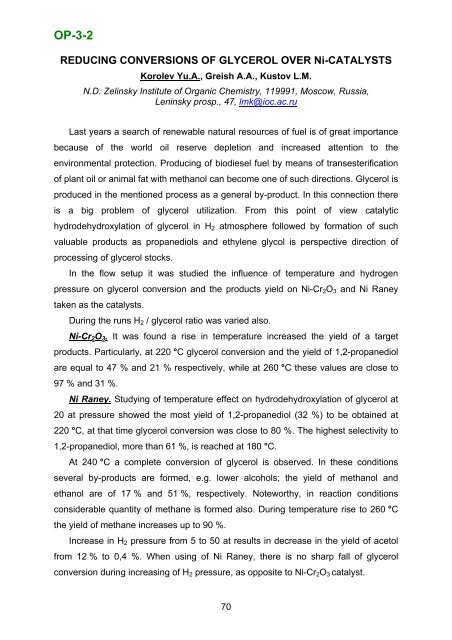Boreskov Institute of Catalysis SB RAS, Novosibirsk, Russia
Boreskov Institute of Catalysis SB RAS, Novosibirsk, Russia
Boreskov Institute of Catalysis SB RAS, Novosibirsk, Russia
- No tags were found...
You also want an ePaper? Increase the reach of your titles
YUMPU automatically turns print PDFs into web optimized ePapers that Google loves.
OP-3-2REDUCING CONVERSIONS OF GLYCEROL OVER Ni-CATALYSTSKorolev Yu.A., Greish A.A., Kustov L.M.N.D. Zelinsky <strong>Institute</strong> <strong>of</strong> Organic Chemistry, 119991, Moscow, <strong>Russia</strong>,Leninsky prosp., 47, lmk@ioc.ac.ruLast years a search <strong>of</strong> renewable natural resources <strong>of</strong> fuel is <strong>of</strong> great importancebecause <strong>of</strong> the world oil reserve depletion and increased attention to theenvironmental protection. Producing <strong>of</strong> biodiesel fuel by means <strong>of</strong> transesterification<strong>of</strong> plant oil or animal fat with methanol can become one <strong>of</strong> such directions. Glycerol isproduced in the mentioned process as a general by-product. In this connection thereis a big problem <strong>of</strong> glycerol utilization. From this point <strong>of</strong> view catalytichydrodehydroxylation <strong>of</strong> glycerol in H 2 atmosphere followed by formation <strong>of</strong> suchvaluable products as propanediols and ethylene glycol is perspective direction <strong>of</strong>processing <strong>of</strong> glycerol stocks.In the flow setup it was studied the influence <strong>of</strong> temperature and hydrogenpressure on glycerol conversion and the products yield on Ni-Cr 2 O 3 and Ni Raneytaken as the catalysts.During the runs H 2 / glycerol ratio was varied also.Ni-Cr 2 O 3 . It was found a rise in temperature increased the yield <strong>of</strong> a targetproducts. Particularly, at 220 °C glycerol conversion and the yield <strong>of</strong> 1,2-propanediolare equal to 47 % and 21 % respectively, while at 260 °C these values are close to97 % and 31 %.Ni Raney. Studying <strong>of</strong> temperature effect on hydrodehydroxylation <strong>of</strong> glycerol at20 at pressure showed the most yield <strong>of</strong> 1,2-propanediol (32 %) to be obtained at220 °C, at that time glycerol conversion was close to 80 %. The highest selectivity to1,2-propanediol, more than 61 %, is reached at 180 °C.At 240 °C a complete conversion <strong>of</strong> glycerol is observed. In these conditionsseveral by-products are formed, e.g. lower alcohols; the yield <strong>of</strong> methanol andethanol are <strong>of</strong> 17 % and 51 %, respectively. Noteworthy, in reaction conditionsconsiderable quantity <strong>of</strong> methane is formed also. During temperature rise to 260 °Cthe yield <strong>of</strong> methane increases up to 90 %.Increase in H 2 pressure from 5 to 50 at results in decrease in the yield <strong>of</strong> acetolfrom 12 % to 0,4 %. When using <strong>of</strong> Ni Raney, there is no sharp fall <strong>of</strong> glycerolconversion during increasing <strong>of</strong> H 2 pressure, as opposite to Ni-Cr 2 O 3 catalyst.70
















